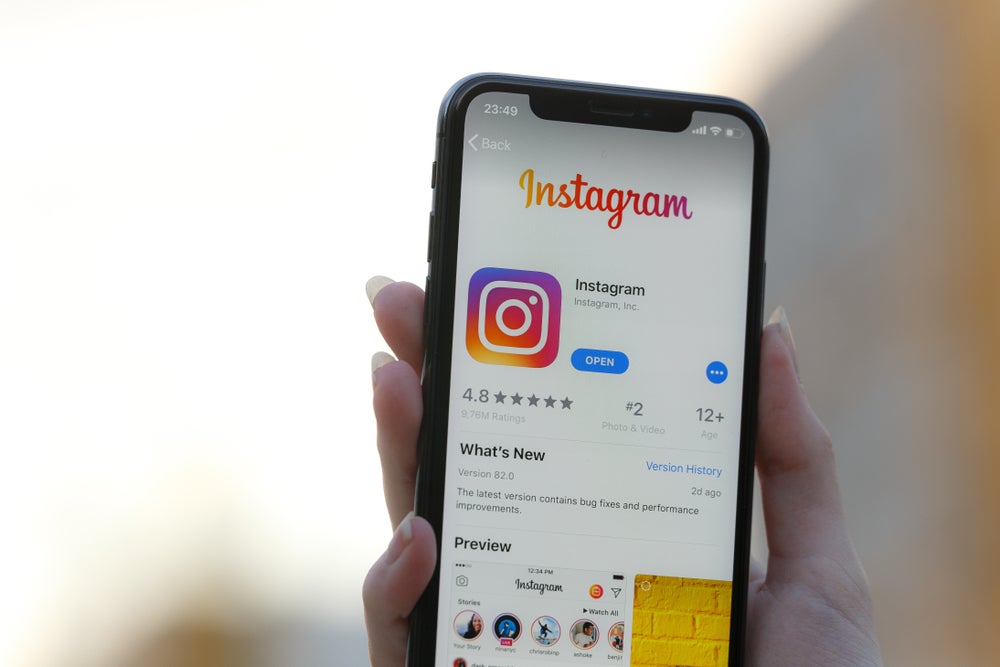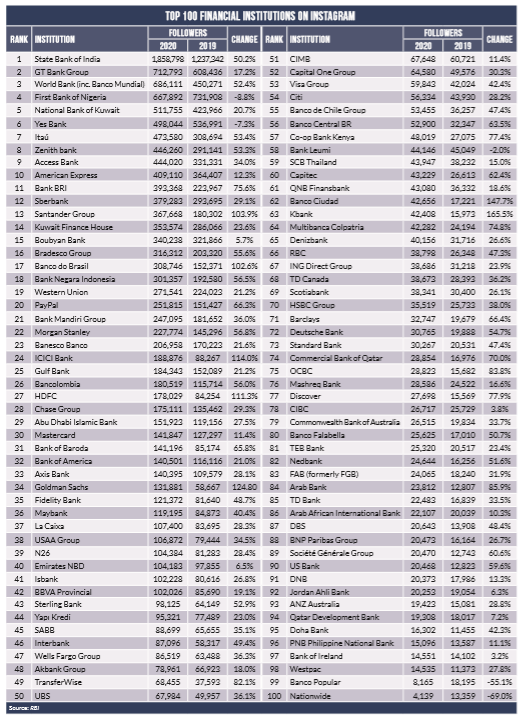
Social media has gained increased significance in marketing – even more so in a world that is continuing its shift to digital approaches. Lucy Dyer looks at this year’s RBI Instagram rankings of the world’s top financial institutions, and talks to banks about the growing role of social media
With the necessity of using social media becoming ever more apparent for banks, Instagram is no exception.
A rising number of banks are promoting themselves on Instagram to attract and connect with clients digitally. In the last few years, financial services have been doing more to expand their following, and as more banks go digital, an online presence is becoming essential for their continued success.
Additionally, the Covid-19 pandemic has only highlighted the importance of technology and having a strong virtual following. In a world that has adapted incredibly fast to living through screens, financial services are trying to keep up.
As the market becomes ever more technologically aware, banks are following suit. RBI’s list of the top 100 financial institutions generally shows steep growths in numbers of bank followers from last year.
This year’s results
Once again, State Bank of India tops the rankings with an impressive 1,858,798 followers. Its follower count has also increased by a huge 600,000 since last year. It has more than double the followers of GT Bank Group, which ranks second, and it remains the only bank to reach million followers. That said, GT has managed to climb two places to claim second position, with World Bank and First Bank of Nigeria not far behind at third and fourth respectively.
Another change is Banco do Brasil, jumping up five places to find itself comfortably inside the top 20 at 16th. The bank has more than doubled its followers in the last year. Paypal has also made it into the top 20, gaining 100,388 followers since the last survey, and taking 20th place.
Even before the pandemic, banks’ shift to digital platforms was clearly evident, with the popularity of branchless and app-led banks on the rise. This shift goes hand in hand with increasing amounts of customers engaging with banks through social media platforms. The year-on-year increase in banks’ Instagram followers confirms this.
Ranking fourth, the movement towards a more digital approach and its importance in relation to platforms such as Instagram has been recognised by First Bank Nigeria.
Chinwe Bode-Akinwande, head of digital marketing and innovations at First Bank Nigeria, tells RBI: “Considering that Instagram is a lifestyle app which is now a key attribute to designing banks’ products and services, it has become fit for purpose. With over one billion users, Instagram is a marketing channel that FirstBank uses to attract younger and more digitally savvy customers as well as other stakeholders, while strategically engaging a host of others effectively on other social and traditional media.”
She continues: “Banking has gone more digital and lifestyle oriented, with transaction cycles now being completed online. Instagram is therefore one of the key tools to not just sell our products, but also to connect with our customers and further reach a new set of potential customers simultaneously.”
Engaging followers
Banks’ social media strategies can have a significant effect on the number of customers with which they engage. Investing more into digital marketing helps banks to distribute relevant content to both followers and potential customers.
“Our strategy is ensuring we are putting out relevant content to our followers and prospects, driving aggressive acquisition and engagements using an always-on approach,” says Bode-Akinwande. “This has seen us make investment in digital marketing activities that continuously drive and meet changing demand while consistently engaging the online community.”
She adds: “We are not just a financial institution, but a part of our customer’s lifestyle. We create initiatives such as DecemberIssaVybe, where we support music, fashion, drama and comedy to reach our target audience – the younger generation – and be part of their lifestyle.
“We have also fine-tuned our communication tone to resonate more with the youth using illustrations, motion graphics, and gifs to sell our products, while leveraging influencer marketing heavily to achieve business goals. We have partnered with our lead digital agency to make this a success.”
Instagram Importance
As Instagram continues to rise in popularity, its importance to banks is also becoming clearer. The platform enables banks to use the content of their own business accounts as well as advertising.
Bode-Akinwande comments: “It surely feels great to have FirstBank rank fourth in the world on one of the fastest-growing social media platforms, Instagram. This is a great feat, and we look forward to topping the list.
“According to Instagram, 60% of people say they discover new products on Instagram, and 200 million-plus Instagrammers visit at least one business profile daily. There has been a 20% rise in time spent watching video on Instagram, and one-third of the most viewed stories are from businesses. With these statistics in view, we believe we are doing well.”
With Instagram’s focus on pictures and videos, banks can use this platform to promote themselves to their audiences in visual and creative ways.
Coming in at 10th on the RBI Instagram rankings, American Express uses the platform to communicate with followers through both Instagram posts and stories.
Leah Gerstner, VP of corporate affairs at American Express, tells RBI: “Social as a
whole is a priority communications channel for American Express for both servicing and storytelling. “Instagram has been a great way for us to translate our messages visually to our card members and communities, from using Instagram stories to showcase the benefits of our cards to rallying our Instagram community to shop small or #BackOurOceans to prevent marine plastic pollution.”
Instagram also gives banks an opportunity to engage followers in various ways, which may be a reason for their growing following on the app each year. Gerstner explains: “We use Instagram to bring our brand narrative to life visually, and to build connections with our customers, colleagues and communities.”
“We do this by sharing stories that uplift, engage and inspire our audience. We love creating and sharing stories about our customers – small business owners to celebrity talent and culture drivers – as well as timely and relevant news – the products and benefits they have access to as card members – and stories that showcase who we are as a brand, through the voices of our colleagues, customers and communities.”
Methods such as these may account for the 12.27% increase in followers seen by American Express since RBI’s 2019 top 100.
Changing approaches
With the recent pandemic affecting customers’ ability to access local branches, it may be that Covid-19 has accelerated banks’ digital and social media strategies. If Covid-19 has not encouraged banks to change strategies, it has certainly highlighted the importance of social media as a point of connection with customers.
When RBI asks if the pandemic has changed banks’ approach to social media, Bode-Akinwande replies: “Not at all! Rather the Covid-19 pandemic has further reinforced the need and value of social media as a strong touchpoint to keep our customers,
prospects and fans updated on our events, products, services and initiatives.
“FirstBank is big on innovation. We have intensified our communication frequency, taking advantage of the spike in social media usage during the pandemic period, while also using our platforms to educate customers on how to stay safe during the period, and encouraging the use of our digital banking channels.”
As well as showing customers ways to stay safe during the pandemic via social media, banks can also publicise support for their own co-workers and communities. Gerstner says: “Now more than ever, it’s important to reinforce how we’re backing our customers, and to make it easy for them to get important information instantly.
“We’ve also been leveraging social to share how we’re supporting our colleagues during this time, as well as the communities where we live and work, including essential workers and others who are putting in countless hours to care for and provide relief to those impacted by the Covid-19 pandemic.”
Both banks seem to agree on the importance of giving customers information in an efficient way. Communication is key for banks in a situation where customer social media use is higher than ever and access to banks is primarily virtual.
Instagram’s future
Social media platforms such as Instagram continue to gain users, which can be a real asset to banks. It can provide useful virtual channels of communication between banks and their clients, and can convey information quickly and easily. It is also a good way of promoting financial services to prospective customers.
As the banking world evolves to become more digitally inclined, keeping clients updated on products and services through a digital lens is becoming a priority. Bank’s efforts are paying off: this is clear through the 40.41% average increase in followers from last year across RBI’s Instagram top 100. Now especially, during the Covid-19 crisis, it is crucial for banks to maintain such communication through platforms such as Instagram.
A switch to a more digital approach – not only as a general rule, but also perhaps accelerated by the pandemic – means a large following on social media like Instagram should become even more desirable for financial institutions in the future.








